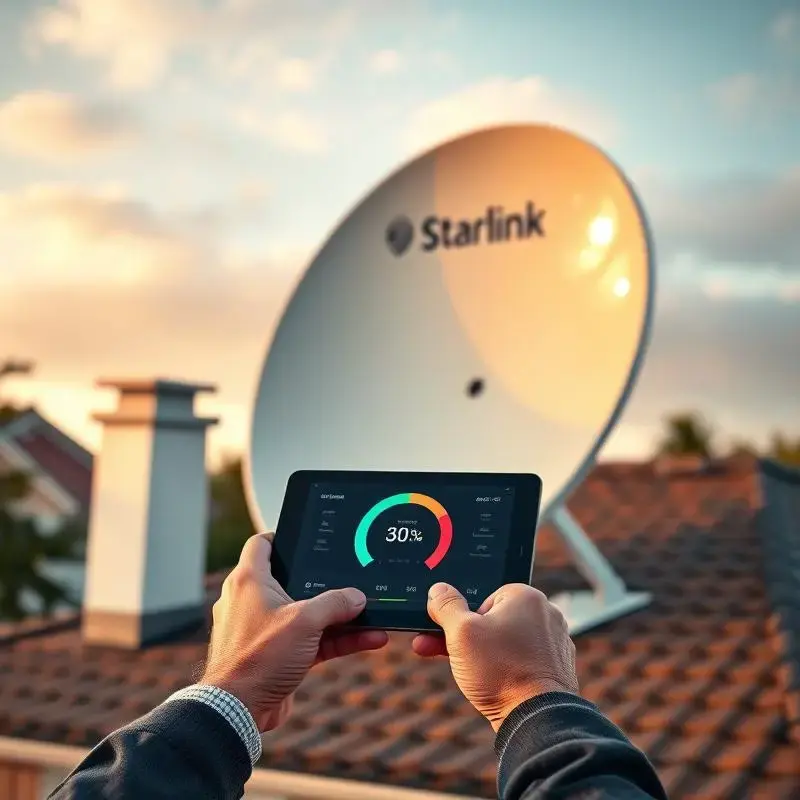Understanding Starlink and Cable Internet Options for Older Adults
Starlink delivers high-speed satellite internet to underserved areas where traditional cable infrastructure often does not reach, making it a compelling option for seniors living in rural or remote locations. Unlike cable internet that relies on physical coaxial or fiber-optic lines, Starlink uses a constellation of low-Earth orbit satellites to beam connectivity directly to a user-installed dish. This fundamental difference means seniors who previously had limited or no cable access can now enjoy broadband speeds comparable to urban cable networks. The Federal Communications Commission defines broadband internet as delivering at least 25 Mbps download and 3 Mbps upload, and both Starlink and modern cable packages exceed these thresholds.
For seniors evaluating internet service, the choice between Starlink and cable hinges on geography, budget, and usage needs. Cable internet remains widely available in suburban and urban areas, often bundled with television and phone services through providers such as Comcast, Spectrum, and Cox. Starlink excels in regions where cable companies have not laid infrastructure, offering a practical lifeline for video calls with family, telehealth appointments, and online banking. Both technologies support essential activities, but understanding eligibility, pricing, and installation requirements is critical to making an informed decision.
Starlink Service Details and Pricing for Seniors
Starlink offers several service tiers, with the Residential plan being the most relevant for individual senior households. As of October 2025, the standard Residential service costs approximately $120 per month, with a one-time hardware fee of $599 for the satellite dish and Wi-Fi router. Starlink does not currently advertise senior-specific discounts, though the company periodically adjusts pricing based on capacity and demand in different regions. Seniors should verify current rates and availability by entering their address on the Starlink website, as service may be limited or waitlisted in high-demand areas.
The Residential plan delivers download speeds ranging from 50 to 200 Mbps under typical conditions, with latency between 20 and 40 milliseconds. These performance metrics support streaming video in high definition, attending virtual medical consultations, and browsing without frustrating delays. Installation is designed for self-service: the kit includes a motorized dish, mounting hardware, and a Wi-Fi router with straightforward setup instructions. Seniors comfortable with basic DIY tasks can complete installation in under an hour, or they may hire a local technician for assistance. Starlink automatically updates firmware and adjusts the dish angle to maintain optimal signal, minimizing ongoing technical intervention.
Cable Internet Packages Tailored to Senior Needs
Major cable providers offer plans that cater to budget-conscious seniors, often featuring lower-tier speeds sufficient for email, video calls, and light streaming. Comcast Xfinity, for example, markets an Internet Essentials plan at $9.95 per month for qualifying low-income households, including seniors receiving Supplemental Security Income or participating in the National School Lunch Program. Spectrum provides a similar program called Internet Assist, priced around $19.99 per month for speeds up to 50 Mbps, targeting households with at least one member aged 65 or older or receiving government assistance. These programs require proof of eligibility and have no long-term contract, no activation fees, and the option to purchase a low-cost modem.
Standard cable internet plans without income requirements typically range from $50 to $90 per month for speeds between 100 and 500 Mbps, depending on the provider and region. Seniors who do not qualify for assistance programs can often negotiate promotional rates for the first year, reducing monthly costs by $10 to $20. Cable installations are usually performed by a technician at no additional charge during promotional periods, and equipment rentals add $10 to $15 per month unless the customer purchases their own modem and router. Bundling internet with cable television or landline phone service may yield further discounts, though seniors should evaluate whether they will use all bundled services to avoid paying for unused features.
Eligibility and Application Process for Assistance Programs
The Affordable Connectivity Program previously provided up to $30 per month toward internet service for eligible low-income households, including many seniors, but funding for this federal initiative concluded in mid-2024. However, individual cable providers continue to operate their own low-cost internet programs with distinct eligibility criteria. To apply for Comcast Internet Essentials or Spectrum Internet Assist, seniors typically need to provide documentation such as an award letter from Social Security, proof of enrollment in a qualifying assistance program, or verification of income below 200 percent of the federal poverty guidelines.
Applications are usually completed online through the provider’s dedicated program portal, or seniors can call customer service for phone-based assistance. Approval often takes one to two weeks, after which the provider schedules installation or mails a self-install kit. It is important to note that these programs are generally available only in areas where the cable company already provides service, and availability does not extend to addresses outside the provider’s coverage footprint. Seniors in rural locations without cable access may instead explore Starlink, which has no income-based eligibility requirements but also lacks subsidized pricing options as of October 2025.
Comparing Performance and Reliability
Cable internet delivers consistent performance in areas with robust infrastructure, offering symmetrical or near-symmetrical upload and download speeds on fiber-hybrid networks. During peak evening hours, cable networks can experience congestion that temporarily reduces speeds, though most modern systems use DOCSIS 3.1 technology to mitigate this issue. Cable outages are relatively rare and usually resolved within hours, with providers maintaining extensive service teams and backup systems. For seniors who rely on internet access for telehealth or emergency communication, cable’s proven reliability in established markets is a significant advantage.
Starlink’s satellite architecture introduces different performance characteristics. Because signals travel to and from space, weather events such as heavy rain or snow can temporarily degrade speeds or interrupt service, a phenomenon known as rain fade. Starlink has improved its system resilience through laser inter-satellite links and a denser satellite constellation, but occasional weather-related disruptions remain more common than with cable. Latency on Starlink has dropped significantly compared to older satellite services, making real-time video calls and online gaming feasible, though cable still edges ahead in this metric. Seniors prioritizing rock-solid reliability for critical applications may favor cable where available, while those in underserved areas will find Starlink’s performance a transformative improvement over dial-up or DSL alternatives.
Installation and Equipment Considerations
Cable internet installation involves a technician visiting the home to connect the coaxial line to a modem, configure the network, and verify signal strength. The process typically takes one to two hours and is scheduled at the customer’s convenience. Seniors receive a modem and often a combination modem-router unit, with setup completed by the technician to ensure immediate connectivity. Equipment is usually rented for a monthly fee, though purchasing a compatible modem outright can save money over the long term. Cable providers supply customer support via phone and online chat, with troubleshooting guides available for common issues.
Starlink’s self-install model places more responsibility on the customer. The kit arrives via courier and includes a satellite dish with a built-in motor, a tripod or roof mount, a 75-foot cable, and a Wi-Fi router. Seniors must position the dish outdoors with a clear view of the sky, free from obstructions such as trees or buildings. The Starlink mobile app provides real-time feedback on optimal placement, using augmented reality to visualize satellite paths. Once powered on, the dish automatically orients itself and establishes a connection within minutes. While the setup is designed to be user-friendly, seniors uncomfortable with outdoor installations may hire a local handyman or satellite installer, typically costing $200 to $400 for labor.
Additional Costs and Long-Term Value
Beyond monthly service fees, seniors should budget for equipment, taxes, and potential service fees. Cable internet equipment rental averages $12 per month, and purchasing a quality modem-router combo costs $100 to $150 upfront. Starlink’s $599 hardware fee is a one-time expense with no additional rental charges, and the company includes a two-year warranty covering manufacturing defects. Both services add state and local taxes, regulatory fees, and sometimes a broadcast surcharge, increasing the effective monthly cost by $5 to $15 depending on jurisdiction.
Over a two-year period, cable internet at $70 per month plus $12 equipment rental totals approximately $1,968, while Starlink at $120 per month plus the $599 initial hardware cost totals $3,479. For seniors in cable-served areas, traditional providers offer better long-term value, especially when low-income programs reduce monthly fees to $10 to $20. Starlink’s higher cost is justified primarily in rural settings where cable is unavailable and the only alternatives are slower DSL or prohibitively expensive fixed wireless options. Seniors should calculate total cost of ownership and weigh it against their specific connectivity needs and location constraints.
Choosing the Right Solution for Your Situation
Seniors living in cities or suburbs with cable infrastructure should prioritize exploring low-income assistance programs first, as these deliver broadband speeds at a fraction of Starlink’s cost. Contacting providers directly and asking about senior discounts or promotional offers can uncover additional savings. For those who qualify for Internet Essentials or Internet Assist, the combination of affordability, reliability, and included customer support makes cable the optimal choice.
Rural seniors without cable access will find Starlink a game-changing technology that brings modern internet to previously disconnected homes. The ability to participate in telehealth, stream entertainment, and maintain video contact with family justifies the higher monthly expense for many households. Seniors should confirm that their property has an unobstructed view of the northern sky (in the Northern Hemisphere) before purchasing Starlink equipment, as nearby trees or buildings can impair signal quality. Checking the Starlink availability map ensures service is not waitlisted in the target area.
Frequently Asked Questions
Does Starlink offer senior discounts? As of October 2025, Starlink does not provide age-based discounts or participate in federal subsidy programs. All customers pay standard rates regardless of age or income. Seniors seeking affordability should compare cable providers’ low-income programs where available.
Can I use Starlink for telehealth appointments? Yes, Starlink’s latency and speeds are sufficient for high-quality video consultations. Ensure the dish is properly installed with a clear sky view to minimize interruptions. Many rural seniors report successful telehealth experiences on Starlink when no cable alternative exists.
What happens if I move? Cable internet requires cancellation and a new installation at the next address, sometimes incurring early termination fees if under contract. Starlink Residential service is tied to a specific address but allows temporary relocation for up to two months per year through the mobile app. Permanent moves require updating the service address, and availability must be confirmed at the new location.
Is there a data cap on Starlink or cable? Most cable providers impose data caps ranging from 1 TB to unlimited, with overage charges if exceeded. Starlink Residential includes unlimited data with no throttling under the Priority Access policy, though the company reserves the right to deprioritize usage during network congestion. For typical senior use cases such as video calls and streaming, neither service’s data policies pose a practical limitation.

